battery INFINITI Q50-HYBRID 2018 Service Manual
[x] Cancel search | Manufacturer: INFINITI, Model Year: 2018, Model line: Q50-HYBRID, Model: INFINITI Q50-HYBRID 2018Pages: 442, PDF Size: 2.9 MB
Page 186 of 442

5 Starting and driving
Precautions when starting and driving ....................... 5-4Exhaust gas (carbon monoxide) .............................. 5-4
Three-way catalyst ..................................................... 5-5
Tire Pressure Monitoring System (TPMS) ............ 5-5
Avoiding collision and rollover ................................. 5-9
Off-road recovery ....................................................... 5-9
Rapid air pressure loss ............................................... 5-9
Drinking alcohol/drugs and driving ...................... 5-10
Intelligent All-Wheel Drive (AWD) driving
safety precautions (AWD models) ........................ 5-10
Push-button ignition switch ......................................... 5-11 Operating range for hybrid system
start function .............................................................. 5-11
Push-button ignition switch operation ............... 5-12
Push-button ignition switch positions ................. 5-12
Emergency hybrid system shut off ....................... 5-13
Intelligent Key battery discharge .......................... 5-13
Before starting the INFINITI Direct Response
Hybrid
®System ................................................................ 5-14
Starting the INFINITI Direct Response
Hybrid
®System ................................................................ 5-14
Remote start ............................................................... 5-15
Driving the vehicle ........................................................... 5-15
Automatic transmission ........................................... 5-15
Parking brake .................................................................. 5-20 INFINITI Drive Mode Selector .................................... 5-21
STANDARD mode ................................................... 5-21
SPORT mode ............................................................ 5-21
SNOW mode ............................................................. 5-21
ECO mode ................................................................. 5-21
PERSONAL mode ................................................... 5-23
Active Lane Control (if so equipped) ........................ 5-24 Active Lane Control operation ............................ 5-26
Turning Active Lane Control ON/OFF ............. 5-27
How to enable/disable Active
Lane Control ............................................................. 5-28
Active Lane Control limitations ........................... 5-29
System temporarily unavailable .......................... 5-30
System malfunction ............................................... 5-30
System maintenance ............................................... 5-31
Lane Departure Warning (LDW)/Lane Departure
Prevention (LDP) (if so equipped) .............................. 5-32 LDW system operation .......................................... 5-33
How to enable/disable the LDW system ......... 5-34
LDP system operation ............................................ 5-34
Turning the LDP system ON/OFF ..................... 5-35
How to enable/disable the LDP system ........... 5-36
LDW/LDP system limitations .............................. 5-36
System temporarily unavailable ........................... 5-37
System malfunction ................................................ 5-38
Page 188 of 442
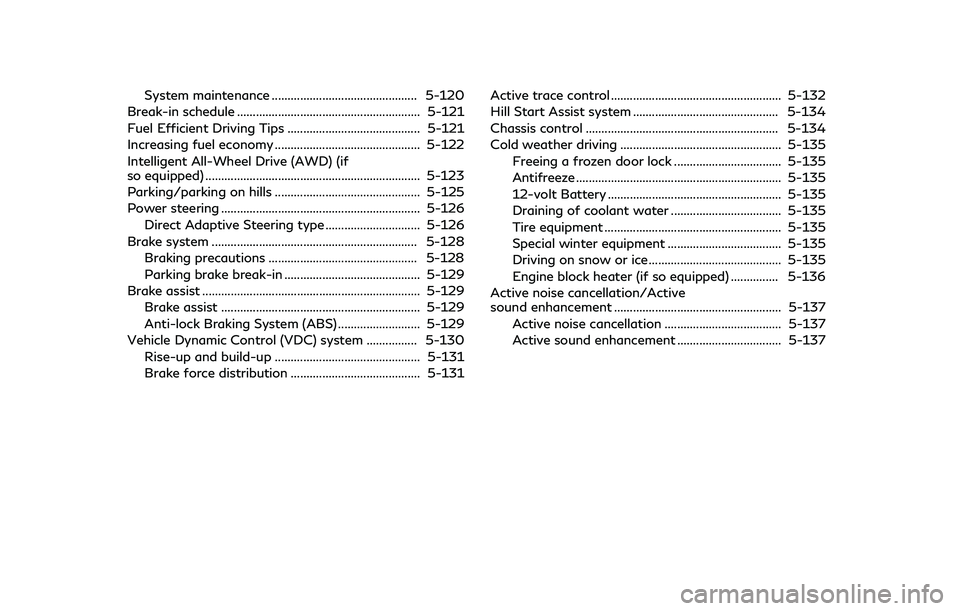
System maintenance .............................................. 5-120
Break-in schedule .......................................................... 5-121
Fuel Efficient Driving Tips .......................................... 5-121
Increasing fuel economy .............................................. 5-122
Intelligent All-Wheel Drive (AWD) (if
so equipped) .................................................................... 5-123
Parking/parking on hills .............................................. 5-125
Power steering ............................................................... 5-126 Direct Adaptive Steering type .............................. 5-126
Brake system ................................................................. 5-128 Braking precautions ............................................... 5-128
Parking brake break-in ........................................... 5-129
Brake assist ..................................................................... 5-129 Brake assist ............................................................... 5-129
Anti-lock Braking System (ABS) .......................... 5-129
Vehicle Dynamic Control (VDC) system ................ 5-130 Rise-up and build-up .............................................. 5-131
Brake force distribution ......................................... 5-131 Active trace control ...................................................... 5-132
Hill Start Assist system .............................................. 5-134
Chassis control ............................................................. 5-134
Cold weather driving ................................................... 5-135
Freeing a frozen door lock .................................. 5-135
Antifreeze ................................................................. 5-135
12-volt Battery ....................................................... 5-135
Draining of coolant water ................................... 5-135
Tire equipment ........................................................ 5-135
Special winter equipment .................................... 5-135
Driving on snow or ice .......................................... 5-135
Engine block heater (if so equipped) ............... 5-136
Active noise cancellation/Active
sound enhancement ..................................................... 5-137
Active noise cancellation ..................................... 5-137
Active sound enhancement ................................. 5-137
Page 196 of 442

.For AWD equipped vehicles, do not
attempt to raise two wheels off the
ground and shift the transmission to
any D (Drive) or R (Reverse) position
with the hybrid system running.
Doing so may result in drivetrain
damage or unexpected vehicle move-
ment which could result in serious
vehicle damage or personal injury.
. Do not attempt to test an AWD
equipped vehicle on a 2-wheel dy-
namometer (such as the dynam-
ometers used by some states for
emissions testing), or similar equip-
ment even if the other two wheels are
raised off the ground. Make sure you
inform test facility personnel that
your vehicle is equipped with AWD
before it is placed on a dynamometer.
Using the wrong test equipment may
result in drivetrain damage or unex-
pected vehicle movement which could
result in serious vehicle damage or
personal injury.
. When a wheel is off the ground due
to an unlevel surface, do not spin the
wheel excessively.WARNING
Do not operate the push-button ignition
switch while driving the vehicle except in
an emergency. (The INFINITI Direct
Response Hybrid
®System will stop
when the ignition switch is pushed 3
consecutive times or the ignition switch
is pushed and held for more than 2
seconds.) If the hybrid system turns off
while the vehicle is being driven, this
could lead to a crash and serious injury.
Before operating the push-button ignition
switch, be sure to move the shift lever to the
P (Park) position.
SSD0659
OPERATING RANGE FOR HYBRID
SYSTEM START FUNCTION
The Intelligent Key can only be used for
starting the hybrid system when the Intelli-
gent Key is within the specified operating
range.
When the Intelligent Key battery is almost
discharged or strong radio waves are pre-
sent near the operating location, the Intelli-
gent Key system’s operating range becomes
narrower and may not function properly.
If the Intelligent Key is within the operating
range, it is possible for anyone, even some-
one who does not carry the Intelligent Key,
to push the ignition switch to start the
Starting and driving5-11
PUSH-BUTTON IGNITION SWITCH
Page 197 of 442
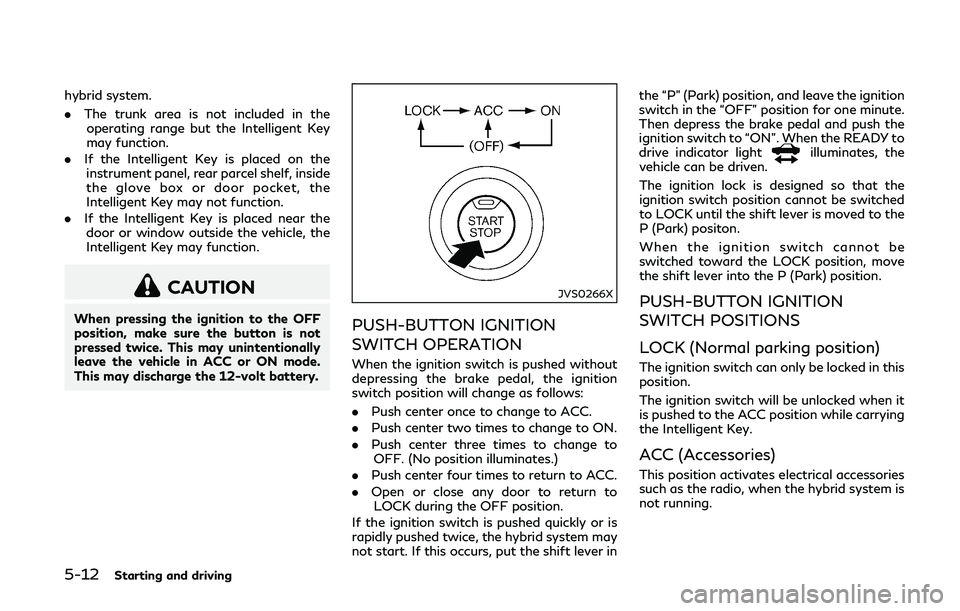
5-12Starting and driving
hybrid system.
.The trunk area is not included in the
operating range but the Intelligent Key
may function.
. If the Intelligent Key is placed on the
instrument panel, rear parcel shelf, inside
the glove box or door pocket, the
Intelligent Key may not function.
. If the Intelligent Key is placed near the
door or window outside the vehicle, the
Intelligent Key may function.
CAUTION
When pressing the ignition to the OFF
position, make sure the button is not
pressed twice. This may unintentionally
leave the vehicle in ACC or ON mode.
This may discharge the 12-volt battery.
JVS0266X
PUSH-BUTTON IGNITION
SWITCH OPERATION
When the ignition switch is pushed without
depressing the brake pedal, the ignition
switch position will change as follows:
. Push center once to change to ACC.
. Push center two times to change to ON.
. Push center three times to change to
OFF. (No position illuminates.)
. Push center four times to return to ACC.
. Open or close any door to return to
LOCK during the OFF position.
If the ignition switch is pushed quickly or is
rapidly pushed twice, the hybrid system may
not start. If this occurs, put the shift lever in the “P” (Park) position, and leave the ignition
switch in the “OFF” position for one minute.
Then depress the brake pedal and push the
ignition switch to “ON”. When the READY to
drive indicator light
illuminates, the
vehicle can be driven.
The ignition lock is designed so that the
ignition switch position cannot be switched
to LOCK until the shift lever is moved to the
P (Park) positon.
When the ignition switch cannot be
switched toward the LOCK position, move
the shift lever into the P (Park) position.
PUSH-BUTTON IGNITION
SWITCH POSITIONS
LOCK (Normal parking position)
The ignition switch can only be locked in this
position.
The ignition switch will be unlocked when it
is pushed to the ACC position while carrying
the Intelligent Key.
ACC (Accessories)
This position activates electrical accessories
such as the radio, when the hybrid system is
not running.
Page 198 of 442
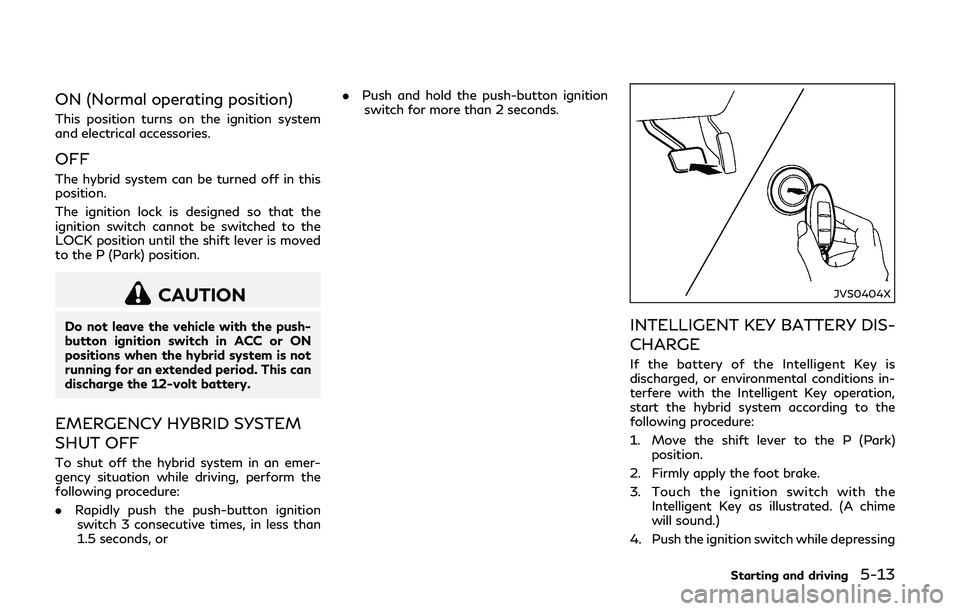
ON (Normal operating position)
This position turns on the ignition system
and electrical accessories.
OFF
The hybrid system can be turned off in this
position.
The ignition lock is designed so that the
ignition switch cannot be switched to the
LOCK position until the shift lever is moved
to the P (Park) position.
CAUTION
Do not leave the vehicle with the push-
button ignition switch in ACC or ON
positions when the hybrid system is not
running for an extended period. This can
discharge the 12-volt battery.
EMERGENCY HYBRID SYSTEM
SHUT OFF
To shut off the hybrid system in an emer-
gency situation while driving, perform the
following procedure:
.Rapidly push the push-button ignition
switch 3 consecutive times, in less than
1.5 seconds, or .
Push and hold the push-button ignition
switch for more than 2 seconds.
JVS0404X
INTELLIGENT KEY BATTERY DIS-
CHARGE
If the battery of the Intelligent Key is
discharged, or environmental conditions in-
terfere with the Intelligent Key operation,
start the hybrid system according to the
following procedure:
1. Move the shift lever to the P (Park) position.
2. Firmly apply the foot brake.
3. Touch the ignition switch with the Intelligent Key as illustrated. (A chime
will sound.)
4. Push the ignition switch while depressing
Starting and driving5-13
Page 199 of 442
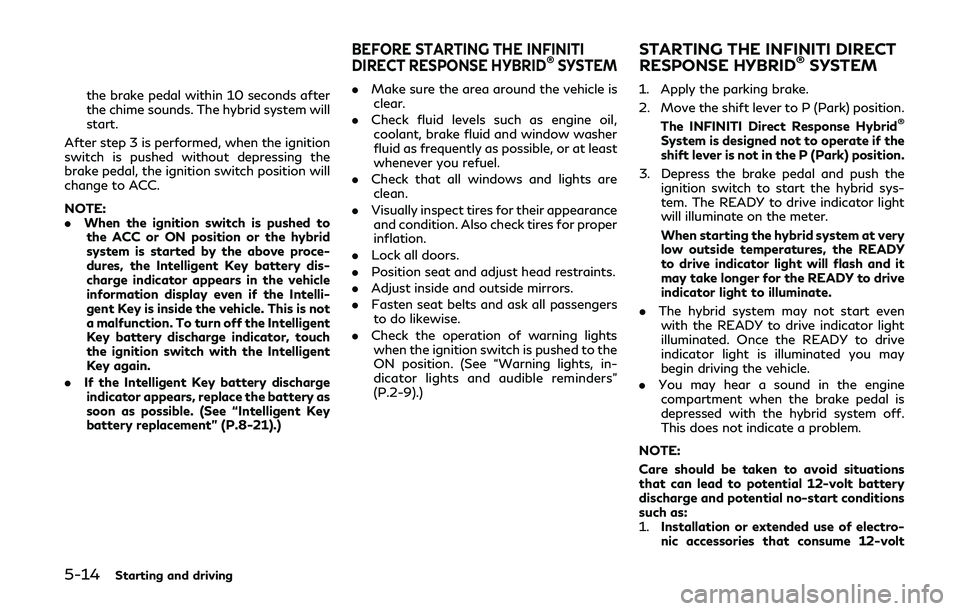
5-14Starting and driving
the brake pedal within 10 seconds after
the chime sounds. The hybrid system will
start.
After step 3 is performed, when the ignition
switch is pushed without depressing the
brake pedal, the ignition switch position will
change to ACC.
NOTE:
. When the ignition switch is pushed to
the ACC or ON position or the hybrid
system is started by the above proce-
dures, the Intelligent Key battery dis-
charge indicator appears in the vehicle
information display even if the Intelli-
gent Key is inside the vehicle. This is not
a malfunction. To turn off the Intelligent
Key battery discharge indicator, touch
the ignition switch with the Intelligent
Key again.
. If the Intelligent Key battery discharge
indicator appears, replace the battery as
soon as possible. (See “Intelligent Key
battery replacement” (P.8-21).) .
Make sure the area around the vehicle is
clear.
. Check fluid levels such as engine oil,
coolant, brake fluid and window washer
fluid as frequently as possible, or at least
whenever you refuel.
. Check that all windows and lights are
clean.
. Visually inspect tires for their appearance
and condition. Also check tires for proper
inflation.
. Lock all doors.
. Position seat and adjust head restraints.
. Adjust inside and outside mirrors.
. Fasten seat belts and ask all passengers
to do likewise.
. Check the operation of warning lights
when the ignition switch is pushed to the
ON position. (See “Warning lights, in-
dicator lights and audible reminders”
(P.2-9).) 1. Apply the parking brake.
2. Move the shift lever to P (Park) position.
The INFINITI Direct Response Hybrid
®
System is designed not to operate if the
shift lever is not in the P (Park) position.
3. Depress the brake pedal and push the ignition switch to start the hybrid sys-
tem. The READY to drive indicator light
will illuminate on the meter.
When starting the hybrid system at very
low outside temperatures, the READY
to drive indicator light will flash and it
may take longer for the READY to drive
indicator light to illuminate.
. The hybrid system may not start even
with the READY to drive indicator light
illuminated. Once the READY to drive
indicator light is illuminated you may
begin driving the vehicle.
. You may hear a sound in the engine
compartment when the brake pedal is
depressed with the hybrid system off.
This does not indicate a problem.
NOTE:
Care should be taken to avoid situations
that can lead to potential 12-volt battery
discharge and potential no-start conditions
such as:
1. Installation or extended use of electro-
nic accessories that consume 12-volt
BEFORE STARTING THE INFINITI
DIRECT RESPONSE HYBRID®SYSTEMSTARTING THE INFINITI DIRECT
RESPONSE HYBRID®SYSTEM
Page 200 of 442

battery power when the hybrid system
is not running (Phone chargers, GPS,
DVD players, etc.)
2. Vehicle is not driven regularly and/or
only driven short distances.
In these cases, the 12-volt battery may
need to be charged to maintain 12-volt
battery health.
REMOTE START
Vehicles started with the remote engine
start function require the ignition switch to
be placed in the ON position before the shift
lever can be moved from the P (Park)
position. To place the ignition switch in the
ON position, perform the following steps:
1. Make sure that the Intelligent Key is on you.
2. Depress the brake pedal.
3. Push the ignition switch once to the ON position.
For additional information about the remote
engine start function, see “Remote engine
start” (P.3-19).
AUTOMATIC TRANSMISSION
The automatic transmission in your vehicle is
electronically controlled by a transmission
control module to produce maximum effi-
ciency and smooth operation.
Shown on the following pages are the
recommended operating procedures for this
transmission. Follow these procedures for
maximum vehicle performance and driving
enjoyment.
Starting the vehicle
After starting the INFINITI Direct Response
Hybrid®System, fully depress the foot brake
pedal and push the shift lever button before
shifting the shift lever to the R (Reverse), N
(Neutral), D (Drive) or Manual shift mode
position. Be sure the vehicle is fully stopped
before attempting to shift the shift lever.
This Automatic Transmission (AT) model is
designed so that the foot brake pedal must
be depressed before shifting from P (Park)
to any drive position while the ignition
switch is in the ON position.
The shift lever cannot be moved out of the P
(Park) position and into any of the other
gear positions if the ignition switch is
pushed to the LOCK, OFF or ACC position.
1. Keep the foot brake pedal depressed and push the shift lever button to shift into a driving gear.
2. Release the parking brake and foot brake, then gradually start the vehicle in
motion.
WARNING
.Do not depress the accelerator pedal
while shifting from P (Park) or N
(Neutral) to R (Reverse), D (Drive) or
manual shift mode. Always depress
the brake pedal until shifting is
completed. Failure to do so could
cause you to lose control and have
an accident.
. Cold engine idle speed is high, so use
caution when shifting into a forward
or reverse gear before the engine has
warmed up.
. Never shift to either P (Park) or R
(Reverse) position while the vehicle is
moving forward and P (Park) or D
(Drive) position while the vehicle is
moving reversing. This could cause an
accident or damage the transmission.
. Do not downshift abruptly on slip-
pery roads. This may cause a loss of
control.
Starting and driving5-15
DRIVING THE VEHICLE
Page 203 of 442
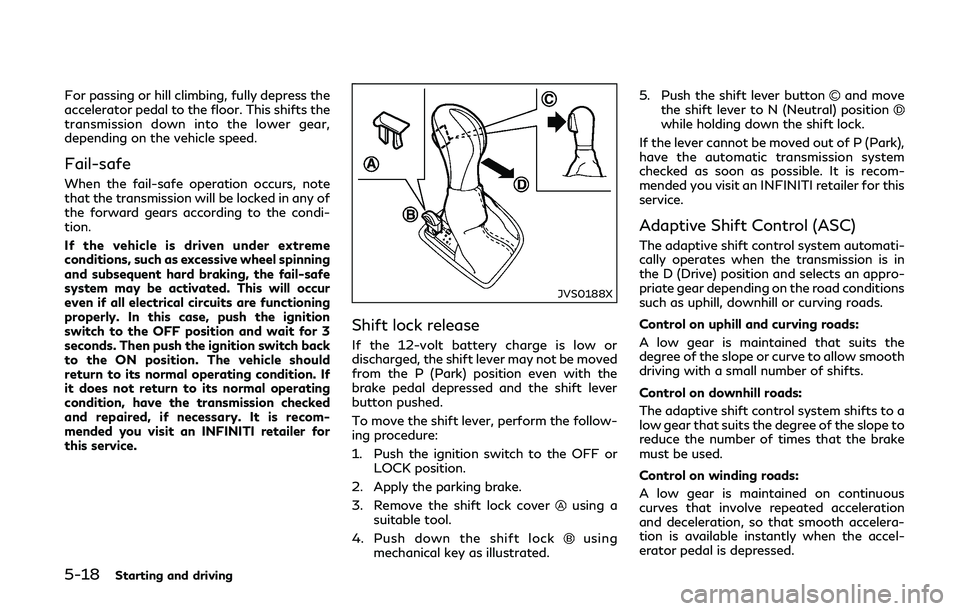
5-18Starting and driving
For passing or hill climbing, fully depress the
accelerator pedal to the floor. This shifts the
transmission down into the lower gear,
depending on the vehicle speed.
Fail-safe
When the fail-safe operation occurs, note
that the transmission will be locked in any of
the forward gears according to the condi-
tion.
If the vehicle is driven under extreme
conditions, such as excessive wheel spinning
and subsequent hard braking, the fail-safe
system may be activated. This will occur
even if all electrical circuits are functioning
properly. In this case, push the ignition
switch to the OFF position and wait for 3
seconds. Then push the ignition switch back
to the ON position. The vehicle should
return to its normal operating condition. If
it does not return to its normal operating
condition, have the transmission checked
and repaired, if necessary. It is recom-
mended you visit an INFINITI retailer for
this service.
JVS0188X
Shift lock release
If the 12-volt battery charge is low or
discharged, the shift lever may not be moved
from the P (Park) position even with the
brake pedal depressed and the shift lever
button pushed.
To move the shift lever, perform the follow-
ing procedure:
1. Push the ignition switch to the OFF orLOCK position.
2. Apply the parking brake.
3. Remove the shift lock cover
using a
suitable tool.
4. Push down the shift lock
using
mechanical key as illustrated. 5. Push the shift lever button
and move
the shift lever to N (Neutral) position
while holding down the shift lock.
If the lever cannot be moved out of P (Park),
have the automatic transmission system
checked as soon as possible. It is recom-
mended you visit an INFINITI retailer for this
service.
Adaptive Shift Control (ASC)
The adaptive shift control system automati-
cally operates when the transmission is in
the D (Drive) position and selects an appro-
priate gear depending on the road conditions
such as uphill, downhill or curving roads.
Control on uphill and curving roads:
A low gear is maintained that suits the
degree of the slope or curve to allow smooth
driving with a small number of shifts.
Control on downhill roads:
The adaptive shift control system shifts to a
low gear that suits the degree of the slope to
reduce the number of times that the brake
must be used.
Control on winding roads:
A low gear is maintained on continuous
curves that involve repeated acceleration
and deceleration, so that smooth accelera-
tion is available instantly when the accel-
erator pedal is depressed.
Page 312 of 442

wheel, may reduce the steering per-
formance.
Direct Adaptive Steering is designed to
control the steering force and steering angle
according to the vehicle speed and amount
of turning of the steering wheel.
The steering characteristic can be selected
using the INFINITI Drive Mode Selector. See
“INFINITI Drive Mode Selector” (P.5-21).
If the VDC system is turned off, the setting
of steering becomes Standard mode.
If the power steering warning light illumi-
nates while the hybrid system is running, it
may indicate that Direct Adaptive Steering is
not functioning properly and may need
servicing. It is recommended you have the
system checked by an INFINITI retailer. (See
“Power steering warning light” (P.2-14).)
When the power steering warning light
illuminates with the hybrid system running,
the power assist for the steering will cease
operation. You will still have control of the
vehicle. However, greater steering effort will
be needed, especially in sharp turns and at
low speeds.
If Direct Adaptive Steering is malfunction-
ing, the steering wheel may turn slightly even
when driving on a straight road.
Under the following conditions, the steering wheel may turn slightly even when driving on
a straight road. This is due to a protection
mechanism for Direct Adaptive Steering. The
steering wheel will return to the normal
position after the protection mechanism is
deactivated.
Condition A
.
When the engine is stalled or likely to be
stalled
. When the steering wheel is held in the full
lock position or when the front tire
touches an obstruction.
. When the battery is discharged
To return the steering wheel to the normal
position, stop the vehicle in a safe location
and stop operating the steering wheel. Then
drive the vehicle for a short period of time.
Condition B
. When the steering wheel is operated
repeatedly or continuously while parking
or driving at a very low speed. In this
case, the power assist for the steering
wheel will be reduced.
To return the steering wheel to the normal
position, stop the vehicle in a safe location
and wait for a period of time, without
operating the steering wheel, until the
temperature of Direct Adaptive Steering
cools down. Avoid repeated steering wheel
operations that could cause Direct Adaptive
Steering to overheat. When the vehicle is tested on the 2-wheel
dynamometer, the power steering warning
light may illuminate. To turn off the power
steering warning light, stop the vehicle in a
safe location, turn the hybrid system off,
restart the hybrid system, and then drive the
vehicle for a period of time.
The following conditions do not indicate a
malfunction of Direct Adaptive Steering.
.
You may notice wider steering play when
the ignition switch is in the OFF or ACC
position compared to when it is in the
ON position.
. After the hybrid system is started, the
steering wheel may turn slightly even
when driving on a straight road. To
return to the normal position, drive the
vehicle on a straight road for a period of
time.
. After the hybrid system is started, the
steering wheel may move if the steering
wheel was turned to the fully locked
position while the ignition switch was in
the OFF position.
. After the vehicle is tested on the 4-wheel
dynamometer, the steering wheel may
turn slightly even when driving on a
straight road. To return the steering
wheel to the normal position, drive the
vehicle on a straight road for a period of
time.
Starting and driving5-127
Page 320 of 442
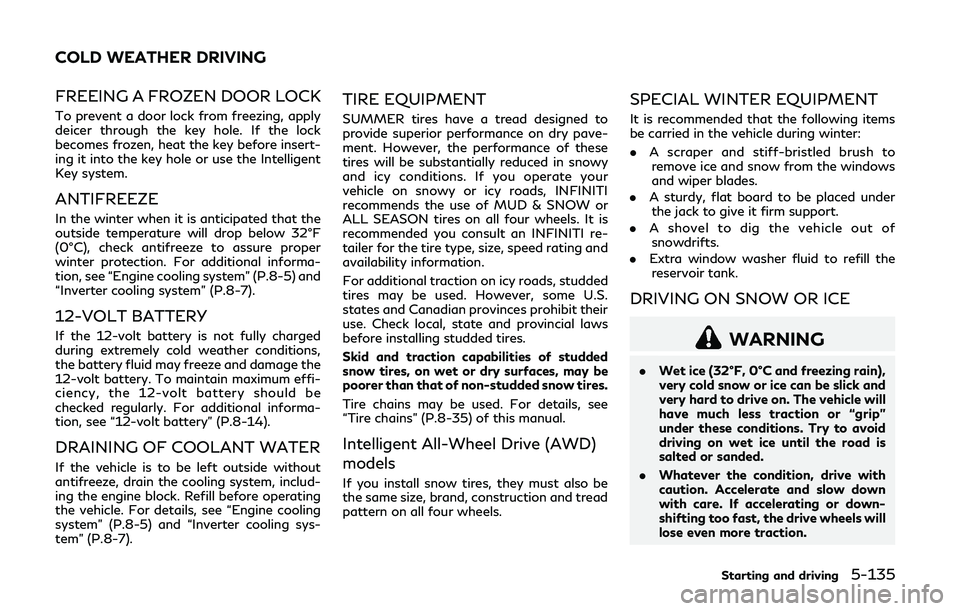
FREEING A FROZEN DOOR LOCK
To prevent a door lock from freezing, apply
deicer through the key hole. If the lock
becomes frozen, heat the key before insert-
ing it into the key hole or use the Intelligent
Key system.
ANTIFREEZE
In the winter when it is anticipated that the
outside temperature will drop below 32°F
(0°C), check antifreeze to assure proper
winter protection. For additional informa-
tion, see “Engine cooling system” (P.8-5) and
“Inverter cooling system” (P.8-7).
12-VOLT BATTERY
If the 12-volt battery is not fully charged
during extremely cold weather conditions,
the battery fluid may freeze and damage the
12-volt battery. To maintain maximum effi-
ciency, the 12-volt battery should be
checked regularly. For additional informa-
tion, see “12-volt battery” (P.8-14).
DRAINING OF COOLANT WATER
If the vehicle is to be left outside without
antifreeze, drain the cooling system, includ-
ing the engine block. Refill before operating
the vehicle. For details, see “Engine cooling
system” (P.8-5) and “Inverter cooling sys-
tem” (P.8-7).
TIRE EQUIPMENT
SUMMER tires have a tread designed to
provide superior performance on dry pave-
ment. However, the performance of these
tires will be substantially reduced in snowy
and icy conditions. If you operate your
vehicle on snowy or icy roads, INFINITI
recommends the use of MUD & SNOW or
ALL SEASON tires on all four wheels. It is
recommended you consult an INFINITI re-
tailer for the tire type, size, speed rating and
availability information.
For additional traction on icy roads, studded
tires may be used. However, some U.S.
states and Canadian provinces prohibit their
use. Check local, state and provincial laws
before installing studded tires.
Skid and traction capabilities of studded
snow tires, on wet or dry surfaces, may be
poorer than that of non-studded snow tires.
Tire chains may be used. For details, see
“Tire chains” (P.8-35) of this manual.
Intelligent All-Wheel Drive (AWD)
models
If you install snow tires, they must also be
the same size, brand, construction and tread
pattern on all four wheels.
SPECIAL WINTER EQUIPMENT
It is recommended that the following items
be carried in the vehicle during winter:
.A scraper and stiff-bristled brush to
remove ice and snow from the windows
and wiper blades.
. A sturdy, flat board to be placed under
the jack to give it firm support.
. A shovel to dig the vehicle out of
snowdrifts.
. Extra window washer fluid to refill the
reservoir tank.
DRIVING ON SNOW OR ICE
WARNING
. Wet ice (32°F, 0°C and freezing rain),
very cold snow or ice can be slick and
very hard to drive on. The vehicle will
have much less traction or “grip”
under these conditions. Try to avoid
driving on wet ice until the road is
salted or sanded.
. Whatever the condition, drive with
caution. Accelerate and slow down
with care. If accelerating or down-
shifting too fast, the drive wheels will
lose even more traction.
Starting and driving5-135
COLD WEATHER DRIVING